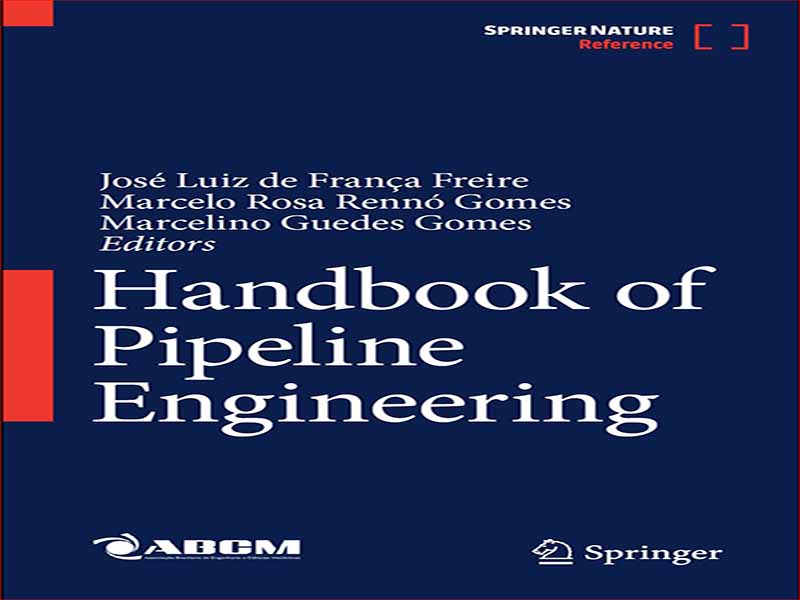- عنوان کتاب: Handbook of Pipeline Engineering
- نویسنده: Jose´ Luiz de Franc¸a Freire
- حوزه: لوله کشی
- سال انتشار: 2024
- تعداد صفحه: 1700
- زبان اصلی: انگلیسی
- نوع فایل: pdf
- حجم فایل: 50.5 مگابایت
در گذشته های نه چندان دور، چربی ها، موم ها و روغن های حیوانی (نهنگ، زیتون و ماهی) عمدتاً به شکل شمع و سوخت فانوس، نور را تامین می کردند. چوب، کاه و سرگین گاو گرما را تامین می کردند. این سوختهای «تجدیدپذیر» پیامدهای مثبتی داشتند – نور و گرما را تأمین میکردند – اما پیامدهای منفی نیز داشتند – ذرات و گازهایی از جمله دیاکسید کربن را آزاد کردند. در حدود دو قرن گذشته، سوختهای غیرقابل تجدید مبتنی بر کربن، با بهبود سلامت و افزایش طول عمر، استاندارد زندگی ما را به میزان قابل توجهی بهتر کردهاند. سوخت های مبتنی بر کربن به شکل جامد، مایع و گاز وجود دارند. سوختهای جامد مانند زغالسنگ با روشهای سنتی از نقطه تولید به نقطه مصرف منتقل شدهاند، اما انرژی مایع و گاز – نفت خام، تولید شده و گاز طبیعی و محصولات حاصل از آنها – باید به روشی جدید منتقل میشد. به دلیل تقاضای زیاد، نیاز به خطوط لوله نفت و گاز ایجاد می شود. در سراسر جهان، با همراهی رشد اقتصادی و جمعیتی بشریت، فعالیت خطوط لوله روشی ایدهآل برای حمل و نقل حجم زیادی از محصولات مایع و گاز و مواد جامد به صورت معلق در فواصل طولانی است. خطوط لوله مزایای زیادی نسبت به سایر اشکال حمل و نقل به ارمغان می آورد، مانند: • قابلیت اطمینان بالا، عملکرد مداوم: تحت تأثیر شرایط آب و هوایی نامطلوب قرار نمی گیرد. درجه بالایی از اتوماسیون در نظارت و مدیریت جریان محصول؛ امنیت بیشتر برای محیط زیست و ایمنی بیشتر برای جمعیت. • اقتصاد بالا در حمل و نقل: اقتصادی تر از سایر روش ها برای حجم زیاد و مسافت های طولانی. • مصرف کم انرژی در مقایسه با سایر روش ها، با توجه به انرژی مصرف شده برای حمل و نقل یک محموله در مسافت یکسان. • کم خطر برای مردم و محیط زیست: به دلیل دفن بودن، با اشغال مسیرهای حمل و نقل مزاحمتی ایجاد نمی کنند. درست است که خطوط لوله به ندرت ممکن است باعث آلودگی و بروز حوادث در صورت وقوع نشت یا پارگی شود. با این حال، داده های آماری نشان می دهد که برای حمل و نقل همان حجم محصول، خطوط لوله روش حمل و نقل را با کمترین تعداد تصادفات ارائه می دهد که باعث افزایش ایمنی و کاهش اثرات زیست محیطی می شود. • انتشار کم گازهای گلخانه ای: در مقایسه با سایر روش های حمل و نقل، خطوط لوله میزان انتشار CO2 کمتری دارند. برای مطالعه این موضوع خط لوله، این هندبوک برای پوشش مرتبط ترین موضوعات مهندسی خط لوله، از مراحل اولیه طراحی، ساخت، بهره برداری و مدیریت یکپارچگی یک خط لوله تا چندین برنامه کاربردی حمل و نقل سیال آنها مانند نفت، گاز طراحی شده است. محصولات نفتی، دوغاب، سوخت های زیستی، هیدروژن و CO2. خطوط لوله سنتی خشکی و دریایی پوشش داده شده است، و همچنین تعامل آینده با جامعه مدرن را ارائه می دهد. درک مهم عمومی از فعالیت های خط لوله نیز ارائه و مورد بحث قرار می گیرد. این کتاب راهنما توسط Springer Nature ابتکار ABCM، انجمن علوم و مهندسی مکانیک برزیل است و در قالب دیجیتال و چاپی موجود است. این با مشارکت مؤثر جامعه بین المللی خط لوله، یعنی با مشارکت متخصصان از کشورها و قاره های مختلف توسعه یافت. از این متخصصان صمیمانه تشکر می کنیم. برخی از ایدهها و نقلقولهای ارائهشده در این پیشگفتار از طریق فصلهایی که توسط آنها نوشته شده است، توسعه مییابد، مانند متون زیر که توسط توماس میسنر در فصل خود «پایداری» توسط رنو و لمگروبر در «چرخه حیات خط لوله» توسط ادمار دی ارائه و توسعه داده شده است. آلمیدا در «انتقال انرژی»، اثر مارسیو کاراپتو در «مجوز اجتماعی»، مولبائر و جیک موری در «ارزیابی و مدیریت ریسک» و کلیف جانسون در «ادراک عمومی». فصل ها بر جنبه های فنی مهندسی یک سیستم خط لوله تمرکز دارند. این اطلاعات یک منبع و راهنمای عالی برای مهندسان خطوط لوله است تا امن ترین و کارآمدترین شبکه خط لوله را حفظ کنند. برای مهندسان، هدف این است که اطمینان حاصل شود که تمام محصولات در سیستم با نشت یا انتشار صفر به کاربر نهایی تحویل داده می شود. ضروری است که مهندسان با آخرین تحقیقات، استانداردها و مقررات به روز باشند تا به رهبری شرکت در اتخاذ تصمیمات تجاری صحیح بر اساس درک سیستم ها و داده هایشان کمک کنند. این کتاب راهنما برنامه ریزی شده است تا به عنوان اولین منبع مرجع برای خوانندگان جدیدی که وارد این حوزه می شوند، اما همچنین به عنوان مکملی برای کسانی باشد که از اصول کلی که حوزه های مهندسی خط لوله را در بر می گیرد آگاه هستند. باید توجه ویژه ای در به روز رسانی YPP – حرفه ای های خط لوله جوان صورت گیرد. YPP یکی از مهم ترین جنبش ها برای تضمین آینده صنعت ما است.
In the recent past, animal fats, waxes, and oils (whale, olive, and fish), mainly in the forms of candles and lantern fuel, provided light. Wood, straw, and cow dung provided heat. These “renewable” fuels had positive consequences—they provided light and heat—but they also had negative consequences—they released particulate and gases, including carbon dioxide. For the past two centuries or so, non-renewable carbon-based fuels have provided cheap energy made our standard of living significantly better, by improving our health and lengthening our life spans. Carbon-based fuels exist in solid, liquid, and gaseous forms. Solid fuels like coal have been moved from the point of production to the point of consumption by traditional means, but liquid and gaseous energy—crude oil, manufactured and natural gas, and the products derived from them—had to be moved in a new way due to great demand, thereby creating the need for oil and gas pipelines. All over the world, by accompanying the economic and population growth of humanity, the activity of pipelines proved to be the ideal modality for the transport of large volumes of liquid and gaseous products, and solids in suspension over long distances. Pipelines bring great advantages relative to other forms of transport, such as: • High reliability, continuous operation: not affected by adverse weather conditions; high degree of automation in the supervision and management of product flow; greater security for the environment and more safety for the population. • High economy in transport: more economic than other modalities for large volumes and long distances. • Low consumption of energy in comparison with other modalities, considering the energy consumed to transport the same cargo over the same distance. • Low risk to the people and the environment: because they are buried, they do not bring inconveniences with the occupation of transport routes. It is true that the pipelines could infrequently pollute and provoke accidents on the occurrence of leaks or ruptures. However, statistical data show that for the transport of the same volume of product, pipelines present the modality of transport with the lowest number of accidents, enhancing safety and reducing environment impacts. • Low emissions of greenhouse gases: in comparison with other modalities of transport, pipelines present a lower rate of CO2 emissions. To study this pipeline matter, this Handbook was conceived to cover the most relevant Pipeline Engineering topics, ranging from the initial stages of designing, constructing, operating, and managing the integrity of a pipeline to several of their fluid transportation applications such as oil, gas, oil products, slurry, biofuels, hydrogen, and CO2. Traditional onshore and offshore pipelines are covered, as well as present the future interaction with modern society. The important public perception to the pipeline’s activities is also presented and discussed. This Handbook production by Springer Nature was an initiative of ABCM, the Brazilian Society of Mechanical Sciences and Engineering, and is available in the digital and print format. It was developed with the effective participation of the international pipeline community, that is, with the participation of professionals from different countries and continents. Our sincere thanks to these professionals. Some of the ideas and quotes presented in this preface are developed through the chapters written by them, such as texts below presented and developed by Thomas Miesner in his chapter “Sustainability,” by Rennó and Lemgruber in “Pipeline Life Cycle,” by Edmar de Almeida in “Energy Transition,” by Marcio Carapeto in “Social License,” by Muhlbauer and Jake Murray in “Risk Assessment and Management,” and by Cliff Johnson in “Public Perception.” The chapters focus on the technical aspects of engineering a pipeline system. The information is a great resource and guide for pipeline engineers to maintain the safest and most efficient pipeline network. For engineers, the goal is to ensure that all products in the system are delivered to the end user with zero leaks or emissions. It is essential that engineers stay current with the latest research, standards, and regulations to assist company leadership in making sound business decisions based on the understanding of their systems and data. This Handbook is planned to serve as a first reference resource for new readers entering the field, but also as a complement to those who are aware of the general principles encompassing areas of pipeline engineering. Special attention needs to be taken in the updating of the YPP—Young Pipeline Professionals. YPP is one of the most important movements to guarantee the future of our industry.
این کتاب را میتوانید از لینک زیر بصورت رایگان دانلود کنید:
Download: Handbook of Pipeline Engineering



































نظرات کاربران